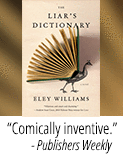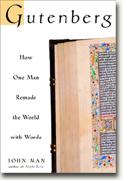The Gutenberg
John Man
book reviews:
· general fiction
· chick lit/romance
· sci-fi/fantasy
· graphic novels
· nonfiction
· audio books
· author interviews
· children's books @
curledupkids.com
· DVD reviews @
curledupdvd.com
newsletter
win books
buy online
links
home
for authors
& publishers
for reviewers


|
The Gutenberg: How One Man Remade the World with Words John Man Wiley, John & Sons Hardcover 320 pages March 2002 |
|
Gutenberg enjoys the paternity of both those books, combining the best of era painting with the liquor of the word when uncorked from the chisel and quill: “For 300 years now, the production of books had brought Christians ever further and ever faster out of the age of darkness that had descended on Europe after the fall of Rome. The flame of learning, tended for a thousand years in a thousand monasteries, burned brighter by the year. Religious books were easier to read, with capital letters marked with colour, and chapter divisions. No longer did monks mutter out loud as they read, as if reading was a form of talk; people actually read to themselves, in silence. As trade links grew and towns evolved, learning escaped from the cloister, and ordinary people began to send their children to school, to learn the three Rs as well as Latin, the language of religion and thus of learning. Universities arose from about 1350, with a consequent demand for books. As paper made from rags became more popular, so books became cheaper. Merchants' offices and city halls had their scribes, and the scribes acquired assistants, and all needed an education, and the teachers needed books, and so literacy spiralled, feeding itself One Italian entrepreneur, Francesco di Marco Datini of Prato, left 140,000 letters when he died in 1410. People, particularly Italians living in a score of trade-rich city-states, already knew they were in the midst of an intellectual and artistic fermentation; the Renaissance was one of those few historical periods that discovered itself, rather than being defined by hindsight.”Thus in 239 words Mr. Man takes us from Rome to the Renaissance and from mutters to majesty. Much of his book has this mix of dustcloth and microscope. He does stop short of tourism writing, perhaps to a fault: the ragpickers he mentions in passing still survive in out-of-the-way Italian and Greek villages, hollering their connect-the-hollers routes through the labyrinths of towns little touched by technology. One of the most delicate tasks when writing about history is to remain rigorous as to the facts while transporting the reader into scenes that feel like they are happening right now, just outside the door, the two-team oxcarts as real as today’s FedEx trucks. In his choice of telling detail Mr. Man is a miniaturist as delightful as any Netherlandish court painter. After quoting a modern Dutch typographer’s description of working with chisels on steel, Mr. Man goes above and beyond the call of historian duty: “This is truly artistry in miniature, a Western version of those Chinese geniuses who wrote on grains of rice. A curl of steel cut in this way is no more than 0.01 millimetres thick, which is the width of a dot on a dot-matrix printer with a resolution of 6.25 million dots per square inch. By comparison, an early dot-matrix had 90,000–120,000 dpi (dots per square inch). Today's laser printers have a resolution of 750,000 dpi (measured in grains of toner rather than old-fashioned dots, but the terminology endures). Now remember that these minute slivers of steel were no more than 0.01 millimetres thick; they could be as little as a tenth of that, just one micron thick (a thousandth of a millimetre, or a twenty-five-thousandth of an inch).With writing like this, you don’t exactly have to step across the cart furrows on your way to check on the goings-on in Weledelherr Gutenberg’s shop across the way, but Mainz and Strasbourg under the deft daub of his pen are the next best thing. Mr. Man mixes the mirror and the macroscope to such adroit facility that Gutenberg the man and Gutenberg the phenomenon come alive as one. As his compatriots have before him, Mr. Man had relatively little hard fact to work with. For all that Gutenberg did for the profusion of the word, he left precious few of his own behind. Little is known about him until the 1440s, by which time he was somewhere in his 40s. He already was renowned for merging the techniques of the coinage trade with the casting of convex mirrorlike buttons, producing thereby countless medallions then in great demand by the trinket trade along pilgrimage routes. One of grander versions of these mirrors is depicted in Jan Van Eyck’s “Marriage of Giovanni Arnolfini.” Think of Gutenberg as having devised the latest thing in 15th century Sai Baba buttons. Frippery perhaps this was, but it led to the development of modern type casting, the key element in the evolution of moveable type. Neither Gutenberg nor even the Western devotion to practical technique were the first at this. At the other end of the Silk Road, as far on it one could get without walking into the sea, a genius surpassing even Gutenberg, Sejong by name, devised both moveable type *and* a written alphabet where “even the sound of the winds, the cry of the crane and the barking of the dog—all may be written.” Lucky Sejong was blessed not merely with intellect and inventiveness, but also the title “Emperor” before his name. This gave him no end of advantage over the average type founder and alphabet inventor. Nor was he the first: the 28-letter Hangul (“Great Script”) he devised was based in part on a script devised by a Tibetan monk named Phangs-pa as a way of systematizing the many tongues of the Mongol Empire. Alas, though Sejong’s efforts resulted in a library of over 160 works printed with moveable type based on Hangul, it did not create an information revolution of the sort inspired by his contemporary colleague in far-off Mainz. Why? Because the Korean elite insisted on sticking with Chinese, in great part because they wanted to preserve their status. Mr. Man’s brief outline of events in Korea hint of a great tale to be told by a novelist—or Mr. Man himself—with a gift for creating in the mind’s eye what the actual eye of the time would have seen. To say nothing of what the nose smelled and the tongue tasted. The sensuality of history is its least-examined feature. Korea’s triumph of elitism wasn’t replicated in the West. The Catholic clergy stuck to Latin, in large part to keep the masses from finding out what they knew and said among themselves. But unlike Korea, the elitism of the Church was underlain by moral and economic corruption so blatant we can scarce imagine it today. Some say that once the words of the Bible became known to anyone who cared to read them, Luther or someone like him was inevitable. Maybe. What was inevitable, though, was the Enlightenment. Nearly everyone today nourishes from the fruits of that tree. Within fifty years of Gutenberg’s first Bible circa 1450, the number of books of all kinds in Europe grew from thousands to millions. Science, literature, and the factual approach to history emerged. Church hegemony collapsed. Kings created nation-states. Proof, not faith, became the criterion of truth. As Mr. Man points put, the book, and no less the man behind it, was the vehicle out of the Dark Ages. It becomes very clear on a second reading of his book, cover to cover and this time looking at the air and light in the room as well as the furnishings, that Mr. Man is no less a scholar to the teeth than the myriads of Ph.D pensters who have made the Middle Ages and Renaissance such a huge section in the Dewey Decimal catalogs. The difference is that Mr. Man can write rings around most historians. Pages 60 and 61 are such a recital of the fakery of the relics and pilgrimage trade that you might take it as satire until you reflect on how many Westerners today pilgrimage to Indian ashrams to lap up equally fanciful interpretations of Hindu legends, without much bothering to put into practice in their daily lives the moral and behavioral principles those gods commend. Maypoles and meanders around the trees of history. If you don’t have a love affair going with today’s forest of words before Mr. Man, you certainly will after him. © 2002 by Dana De Zoysa for Curled Up With a Good Book |
|
|
|
 Click here to learn more about this month's sponsor! |
|
| fiction · sf/f · comic books · nonfiction · audio newsletter · free book contest · buy books online review index · links · · authors & publishers reviewers |
|
| site by ELBO Computing Resources, Inc. | |